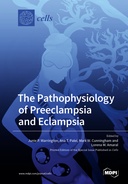Explore

The Pathophysiology of Preeclampsia and Eclampsia
0 Ungluers have
Faved this Work
Login to Fave
Preeclampsia is a hypertensive disorder of pregnancy, diagnosed after the 20th week of gestation in women experiencing new-onset hypertension along with symptoms affecting the liver, kidneys, or brain. In some cases, women with preeclampsia develop novel seizures or unexplained coma, at which time they are diagnosed with eclampsia. The mechanisms contributing to preeclampsia and eclampsia are not fully elucidated, although the placenta seems to play a critical role. Previous studies suggest that improper placentation stimulates mitochondrial dysfunction and the exaggerated release of placental-derived molecules including inflammatory cytokines, anti-angiogenic factors, reactive oxygen species, and cell-free nucleic acids into the maternal circulation that cause systemic vascular dysfunction. These, along with maternally derived molecules, act in concert, leading to hypertension and target organ damage during pregnancies complicated by preeclampsia and eclampsia.In this reprint, we present the original research articles and review papers published as part of the Special Issue: "The Pathophysiology of Preeclampsia and Eclampsia" in Cells.
This book is included in DOAB.
Why read this book? Have your say.
You must be logged in to comment.
Rights Information
Are you the author or publisher of this work? If so, you can claim it as yours by registering as an Unglue.it rights holder.Downloads
This work has been downloaded 111 times via unglue.it ebook links.
- 111 - pdf (CC BY) at Unglue.it.
Keywords
- activin A
- adipokines
- adiponectin
- adrenoceptor
- AGTR1 (angiotensin II receptor type 1)
- angiogenic factors
- Angiotensin II
- anti-inflammation
- antioxidant
- ARRB (beta-arrestin)
- ASIC2a
- AT1R-B2R heteromer (protein complex formed of AT1R-B2R)
- BDKRB2 (bradykinin receptor B2)
- Biobank
- biomarkers
- Blood pressure
- Blood-Brain Barrier
- blood–brain barrier
- bradykinin
- cardiac dysfunction
- cerebral biomarkers
- cerebral edema
- Database
- early-onset preeclampsia
- eclampsia
- endothelial cell activation
- endothelial dysfunction
- erythrocyte
- exosome
- extracellular vesicle
- fetal growth restriction
- fusion
- G-protein-coupled receptor
- G-protein-coupled receptors
- gestation
- glucose transporter 9
- GLUT9
- GPCR
- Hemorheology
- Hypertension
- hypoxia
- hypoxia/reoxygenation
- IL-2
- In vitro studies
- Inflammation
- ischaemia
- Leptin
- maternal chronic venous disease (CVeD)
- medicine
- Melatonin
- misfold proteins
- nebivolol
- neuroinflammation
- NFL
- Nitric Oxide
- NLRP3
- NSE
- Obesity
- Oxidative Stress
- p21Cip1/CDKN1A
- pentylenetetrazol
- Placenta
- placental factors
- placental ischemia
- Pre-Eclampsia
- Preeclampsia
- Pregnancy
- primary trophoblast
- protein aggregation
- pulmonary oedema
- red blood cell aggregation
- red blood cell deformability
- ROS
- RUPP
- S100b
- seizure
- sFlt-1
- sFlT-1/PlGF ratio
- tau
- trophoblast
- trophoblast organoids
- trophoblasts
- uric acid
- vessel
- Vitamin E
- weighted gene correlation network analysis
- WGCNA
Links
DOI: 10.3390/books978-3-0365-6410-4Editions

